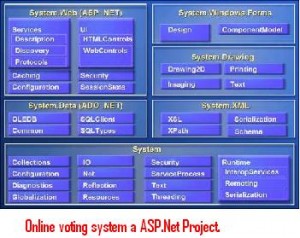Introduction: The project “Online voting system a ASP.Net Project” aims at creating a system through which the voting process is made easier in cooperative societies. In the current system, voting is performed by using ballot paper and then the counting is executed manually. This is a time consuming process and involves manual effort. It might also lead to the possibility of invalid votes. All the above tedious tasks are eliminated in the above process. In the system discussed here, the counting of votes is done by using a computer. This saves time and also avoids the errors that might occur during the election process. The system is designed with the coding language ASP.Net with C# and the database is SQL Server 2005.
All the above tedious tasks are eliminated in the above process. In the system discussed here, the counting of votes is done by using a computer. This saves time and also avoids the errors that might occur during the election process. The system is designed with the coding language ASP.Net with C# and the database is SQL Server 2005.
ASP.Net online Voting Project description:
The project Online Voting system is designed to count the number of votes and thereby calculate the percentage of votes. Also the number of vote a candidate obtains is also obtained. Along with the number the percentage of votes for each candidate is calculated. The system is so designed that it can also check for duplication. It then decides the winner in every section. The project is designed with a modular approach and the number of modules is decided as per the requirements of the organization. The two modules are administrator module and the user module. The administrator has total authority of the organization and maintains all the aspects. The user has the provision to view the list of all candidates and results as well as vote for the desired candidates.
Conclusion: Once the system is designed the software is tested in order to see the validity of the system is established. This is the method by which functionality of components is checked. After the system is tested then a trial run of the system is done so that errors if any can be eliminated.
Download Project Report of CSE Online voting system a ASP.Net Project.

